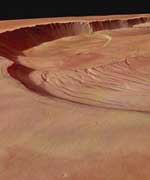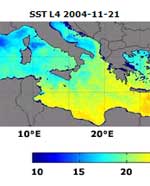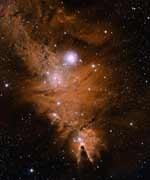
Image credit: ESA
This perspective view, taken by the High Resolution Stereo Camera (HRSC) on board ESA’s Mars Express spacecraft, shows the complex caldera of Olympus Mons on Mars, the highest volcano in our Solar System. It may also offer the best chance to find more geologically recent volcanic activity on Mars.
“We would be very lucky to see [an eruption], but it would be a massive event,” said Gerhard Neukum in USA Today. Neukum is a professor at Berlin’s Free University and lead author of a study in Nature magazine suggesting a revised timeline for lava on Mars.
While Mars is littered with collapsed volcano remnants, none have been observed as active right now. The new images indicate some of these volcanoes are merely dormant, not dead. The timeline proposed from studying the complex Olympus Mons caldera suggests there have been lava flows from intense volcanic activity within the past 2 million years.
To geologists, two million years is regarded as recent since it corresponds to the last one percent of the planet’s history.
For instance, the curved striations on the left and foreground, in the southern part of the caldera, are tectonic faults. After lava production has ceased the caldera collapsed over the emptied magma chamber. Through the collapse the surface suffers from extension and so extensional fractures are formed.
“I suspect that as we get more spacecraft in orbit that it will increase the chances of seeing some kind of active eruption,” said Dr. James W. Head III, a professor of geological sciences at Brown. As quoted in Associated Press commentary, Dr. Head is one of more than 40 scientists who contributed to analysis of the images.
The level plain inside the crater on which these fractures can be observed represents the oldest caldera collapse. Later lava production caused new caldera collapses at different locations (the other circular depressions). They have partly destroyed the circular fracture pattern of the oldest one.
This perspective view of the caldera was calculated from the digital elevation model derived from the stereo channels and combined with the nadir and color channels of the HRSC.
University of Buffalo volcanologist, Dr. Tracy Gregg, discussed the scientific appeal of studying Martian volcanoes in detail. “If both of these [Opportunity and Spirit] landers survive with airbag technology, then it blows the doors wide open for future Mars landing sites with far more interesting terrain. A landing site near a volcano might be possible, now that the airbag technology has worked so wonderfully.”
The current generation of Mars missions has adopted the theme, “Follow the Water”, as a quest to understand the complex geological history of a planet that may have had significant reserves once. For that much warmer and wetter Mars, this motto also requires other ingredients for microbial life, including primordial “fire” in the form of biological temperature ranges and potentially geothermal heat.
“I’d like to see us land ON a volcano,” said Gregg. “Right on the flanks. Often the best place to look for evidence of life on any planet is near volcanoes.”
“That may sound counterintuitive, but think about Yellowstone National Park , which really is nothing but a huge volcano,” said Gregg. “Even when the weather in Wyoming is 20 below zero, all the geysers, which are fed by volcanic heat, are swarming with bacteria and all kinds of happy little things cruising around in the water. So, since we think that the necessary ingredients for life on earth were water and heat, we are looking for the same things on Mars, and while we definitely have evidence of water there, we still are looking for a source of heat.”
While Olympus Mons is dormant today, volcanologists are not entirely convinced more isn’t going on geothermally on Mars. “If you’d asked me [if there were not active surface volcanoes] 10 years ago–or even 5–I might’ve said yes,” said Gregg. “Now I’m not so sure.”
On Mars, “where would I look for recent volcanic activity? Depends on how you want to define it on Mars,” said Gregg. “I strongly suspect there are still molten (or at least mushy) magma bodies beneath the huge Tharsis volcanoes , and beneath Elysium Mons .”
“But the youngest surficial activity discovered to date (and it’s probably 1 million years old, which would be considered quite young, and possibly ‘active’ on Mars) is in a region that contains no large volcanic structures of any kind,” said Gregg. “Instead, there are cracks in the ground, and a few low-lying volcanoes that can’t even be seen except in the high-resolution topography (they are too subtle for imagery to reveal). This area is called Cerberus Fossae .”
Seeing important events surrounding Olympus Mons is not entirely just about geology, as the famed science fiction writer, Sir Arthur C. Clarke, indicated this was the site for his own version of desktop terraforming. “Soon after maps of the real Mars became available, I received a generous gift from computer genius John Hinkley–his Vistapro image-processing system. This prompted me to do some desktop terraforming (a word, incidently, invented by science fictions’ Grandest of Grand Masters, Jack Williamson). I must confess that in ‘The Snows of Olympus: A Garden on Mars’ (1995) I frequently allowed artistic considerations to override scientific ones. Thus I couldn’t resist putting a lake in the caldera of Mount Olympus, unlikely though it is that the strenuous efforts of future colonists will produce an atmosphere dense enough to permit liquid water at such an altitude.”
Original Source: NASA Astrobiology Magazine


